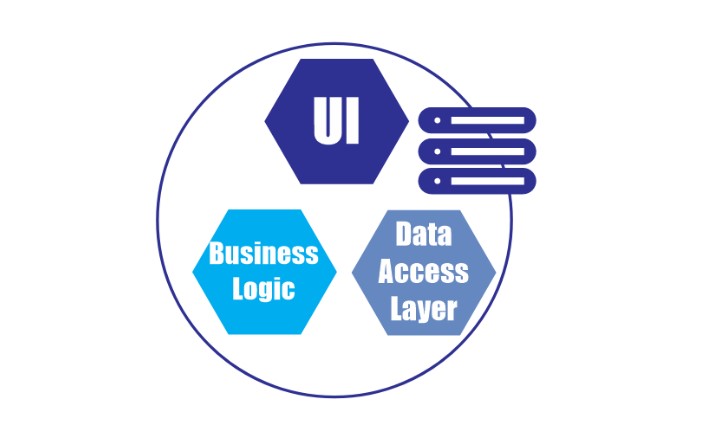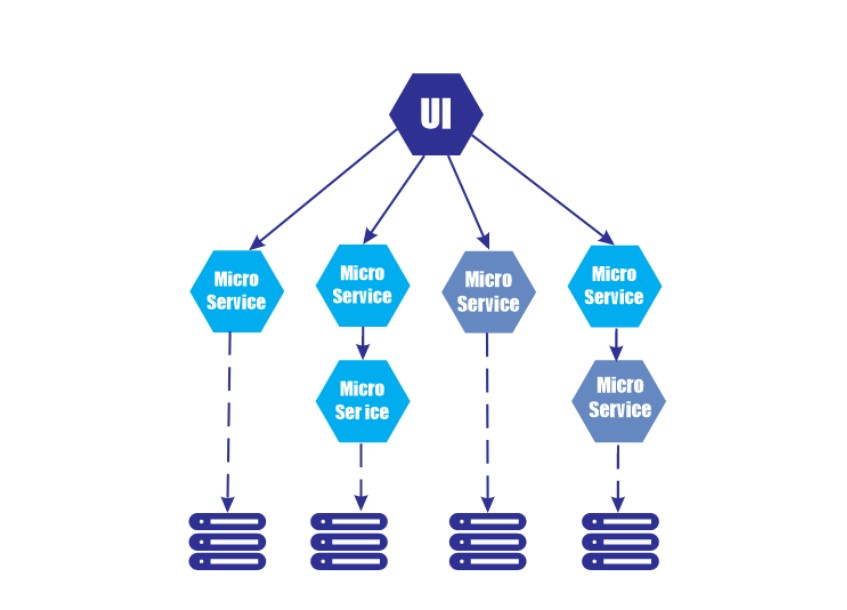A monolithic application is an application in which the whole system (functionalities, user interface, and data layers) is built as a single unit, while a microservices architecture is a collection of smaller, independently deployable services.
What is Monolithic Architecture?
A monolithic architecture is a traditional model of a software program that is built as a unified self-contained unit that is independent from other applications.
The word monolith is often attributed to something large and glacial. A monolithic architecture, just as the name implies, is a large singular computing network with one code base that couples all the business concerns together.
To modify this kind of application, you would need to update the entire stack by accessing the code base and building, then deploy an updated version of the service site interface. Now this makes updates restrictive and time-consuming, though easier from scratch. Here’s what I mean;
Monoliths allow for ease of code management, cognitive overhead, and deployment at the early stages of product development, but become inconvenient as the project grows.

In monolithic architecture, each component and its associated components must all be present for a code to be completely compiled and executed.
Monolithic applications are single-tier, which means multiple components are combined into one large application.
Additionally, if one program component must be updated, other elements may also require rewriting, and the whole application has to be recompiled and tested.
A banking application is a good example of a monolithic architecture.
The banking application website first authorizes customers, logs them into their accounts, and enables them to make online money transfers to other accounts.
There are numerous components involved in this entire process. These include; customer-facing user interface services for using authentication statements, downloads, money transfers, and so on.
If the application uses a monolithic architecture, it is built and deployed as a single application regardless of how a customer uses it.
Consequently, the application remains tightly coupled regardless of how the user accesses it, both from a PC or a mobile device. This is because all the components and modules are directly connected.
Now let’s juxtapose monoliths with microservices.
What are Microservices?
A Microservice software architecture or service is a method that relies on a series of independently deployable services.
These services have their own business logic and data structure with a specific goal. Updating, testing, deployment, and scaling occur independently of each other.
This architecture decouples major business domain-specific concerns into separate independent code bases. They don’t reduce complexity, rather they make tasks visible and more manageable by separating them into smaller bits(microservices). These bits then act together to make a whole application operate.
They utilize APIs to pass information such as user queries or a data stream from one service to another.

Why Migrate From Monolithic To Microservices?
A common relatable example that will help you understand this concept is the use-case of Netflix.
Netflix is one of the earliest and most popular adopters of microservices. Some other adopters include; eBay, Amazon, Twitter, Alisan, etc.
In 2009, Netflix needed to modify its infrastructure to keep up with the demand for its rapidly growing video streaming services.
The company decided to migrate its infrastructure from a private data center to a public cloud and replace its monolithic architecture with a microservices architecture.
Netflix became one of the first high-profile companies to successfully migrate from a monolith to a cloud-based microservice architecture and today?
Netflix has more than 10,000 microservices that manage and support separate parts of the platform while its engineers deploy code frequently, sometimes thousands of times each day.
Another good example is Atlassian Corporation PLC or Public Company Limited.
It’s a software company founded in 2002 and its headquarters is in Sydney, Australia. They develop products for software developers, project managers, and other software development teams. Atlan followed the PA to microservices in 2018.
After they faced growing and scaling challenges with Jira and Confluence, they found that their single-tenant monolithic architecture running on-premises wouldn’t serve future needs.
To resolve this, they decided to re-arrange Jira and Confluence and move them from a stateful single-tenant monolithic system to a multitenant stateless cloud application hosted by Amazon Web Services.
This transition to AWS took 2 years to complete. In 10 months they successfully migrated more than 100k customers with no service interruption.
The project was named Vertigo and it stands as their largest infrastructure project to date.
Now that we have the same point of view, let’s delve completely into the comparison of monolithic versus microservices.
Important Differences Between Monolithic and Microservices
Both differ in the following ways;
1. Definitions
A monolithic architecture is a traditional model of software programs that is built as a unified unit that is self-contained and independent from other applications.
On the other hand, a microservices architecture, also known as microservices, is an architectural method that relies on a series of independent deployable services.
2. Deployment Ease
In monolithic architecture, one executable file or directory makes deployment easier, whereas, in microservices architecture, they are independently deployable since microservices are individual units and allow for fast and easy independent deployment of individual features.
3. Flexibility
In monolithic architecture, you have to replicate the whole application when scaling, and this can result in inefficiencies and tie-ups since all the components are strictly integrated.
Whereas in microservices, due to flexible scaling, if a microservice reaches load capacity, new instances of that service can be rapidly deployed independently, reducing pressure without affecting the whole system.
4. Reliability
In monolithic architecture; if there’s an error in any module, it could affect the entire application’s availability. On the contrary, with microservice architecture, you can deploy changes from a specific service without the threat of bringing down the entire application.
5. Development Complexity
In monolithic architecture, when an application is built with one code base, it is easier to develop, whereas microservices add more complexity due to multiple services designed by multiple teams.
6. Effect of Technology Choice
Monolithic architecture is rather rigid than flexible because it’s constrained by the technologies already used in the monolith whereas microservices architecture is flexible since it allows teams to select the tools they desire.
7. Debugging
In monolithic architecture, debugging is easier since all codes are located in one place. It’s easier to follow a request and find an issue. On the other hand, each microservices has its own set of locks which makes debugging more complicated.
Conclusion
Determining whether or not to use microservice architecture is dependent on several factors which includes but not limited to complexity, scale and growth stage of the application. Even though microservices offer flexibility, scalability and resilience, it is not always necessary when the application does not require it. It might be best suitable for large scale systems but not for smaller, simpler and early-stage products where rapid development, lower maintenance costs and ease of debugging are the key priorities.
So I suggest:
Use Microservices when:
- The application has outgrown monolithic structure and the independent functions need separate scaling.
- The application requires frequent updates which will usually impact system uptime.
- When the several components that make up the system require different tech stack preference.
- When there are multiple teams working on different business domains
- When it is necessary to isolate errors from individual service without impacting the whole system
Use Monolithic Architecture when:
- The application is still in early development stage and does not require much complexities yet
- It is important to have a straightforward development, simpler code base
- You have a small team size because a simple codebase allows for better collaboration and fewer dependencies.
- It is possible to meet up with performance needs without overhead complexity of microservices.






